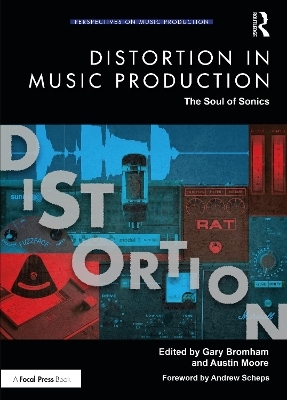
Distortion in Music Production
CRC Press (Verlag)
978-0-367-40585-4 (ISBN)
Distortion in Music Production offers a range of valuable perspectives on how engineers and producers use distortion and colouration as production tools. Readers are provided with detailed and informed considerations on the use of non-linear signal processing, by authors working in a wide array of academic, creative, and professional contexts.
Including comprehensive coverage of the process, as well as historical perspectives and future innovations, this book features interviews and contributions from academics and industry practitioners. Distortion in Music Production also explores ways in which music producers can implement the process in their work and how the effect can be used and abused through examination from technical, practical, and musicological perspectives.
This text is one of the first to offer an extensive investigation of distortion in music production and constitutes essential reading for students and practitioners working in music production.
Gary Bromham is a composer, artist, music producer and mix engineer. Also a researcher and published author who recently completed a PhD in Computer Science, specifically in music and timbre perception, at Queen Mary, University London. He began his career as a Fairlight programmer and a tape op at Trident Studios in London. He subsequently began his songwriting and music production career in Iceland. During this time, he co-produced the 1988 Icelandic Eurovision entry, made an album with jazz-funk band Mezzoforte, and worked with progressive artist, Bjork. Whilst collaborating with Andrew Ridgeley, of Wham, on his solo album, he was also fortunate enough to work with George Michael on some of his album, Listen Without Prejudice. As a result of his collaboration with George Michael and Andrew Ridgeley he was offered his first publishing contract with Warner Chappell Music in 1990. This proved to be a great success. He has written with many varied and successful artists and songwriters including Sheryl Crow, Bow Wow Wow, The Tubes, Robbie Neville, Eddie Money and The Fixx to name but a few, spending a large period of his time working in New York, Nashville and Los Angeles. Later collaborations include Editors, Graham Coxon from Blur, The Maccabees, Lulu, Delta Goodrem and again Sheryl Crow on her single, ‘Soak up the Sun’. He was also signed to EMI Records in 1996 as a recording artist in the band The Big Blue. They released two singles and achieved moderate success. He has just completed his PhD at Queen Mary University London where he is researching the role of retro aesthetics in music production and how some of these features are used in intelligent music production systems. He has several publications in this ever-expanding field. He is currently recording as an artist using the project name Convergence. Austin Moore is a senior lecturer and course leader of sound engineering and music production courses at the University of Huddersfield, UK, where he is also the Music and Audio Production (MAP) research group leader. He completed a PhD in music production and technology, which investigated the use of non-linearity in music production, with a focus on dynamic range compression and the 1176 compressor. His research interests include music production sonic signatures, Atmos in music production, and semantic audio. He has a background in the music industry and spent many years producing and remixing various forms of electronic dance music under numerous artist names and working as an engineer in studios.
Part I Technology of Distortion 1. A History of Distortion in Music Production; 2. The Development of Audio Software with Distortion; 3. A Browser-based WebAudio Ecosystem to Dynamically Play with Real-time Simulations of Historic Guitar Tube Amps and Their Typical Distortions; 4. Non-linearity and Dynamic Range Compressors; 5. Low Order Distortion in Creative Recording and Mixing; Part II Perception and Semantics of Distortion 6. Understanding the Semantics of Distortion; 7. An Ecological Approach to Distortion in Mixing Audio: Is Distortion an Expected, Rather than an Unwanted Artefact?; 8. Towards a Lexicon for Distortion Pedals; Part III Retrospective Perspectives of Distortion 9. Hit Hardware: Vintage Processing Technologies and the Modern Recordist; 10. Even Better than the Real Thing: A Comparison of Traditional and Software-Emulated Distortion in the Contemporary Audio Production Workflow; 11. ‘It Just Is My Inner Refusal’: Innovation and Conservatism in Guitar Amplification Technology; 12. A Saturated Market; Part IV Musicology of Distortion 13. The Studio’s Function in Creating Distortion Related Compositional Structures in Hard Rock and Heavy Metal; 14. The Distortion of Space in Music Production; 15. Distorting Jazz Guitar: Distortion as Effect, Creative Tool and Extension of the Instrument; 16. 'Got a Flaming Heart': Vocal Climax in the Music of Led Zeppelin; 17. The Aesthetics of Distortion
| Erscheinungsdatum | 11.07.2023 |
|---|---|
| Reihe/Serie | Perspectives on Music Production |
| Zusatzinfo | 11 Tables, black and white; 12 Line drawings, black and white; 97 Halftones, black and white; 109 Illustrations, black and white |
| Verlagsort | London |
| Sprache | englisch |
| Maße | 174 x 246 mm |
| Gewicht | 640 g |
| Themenwelt | Kunst / Musik / Theater ► Musik ► Musiktheorie / Musiklehre |
| Mathematik / Informatik ► Informatik | |
| ISBN-10 | 0-367-40585-7 / 0367405857 |
| ISBN-13 | 978-0-367-40585-4 / 9780367405854 |
| Zustand | Neuware |
| Informationen gemäß Produktsicherheitsverordnung (GPSR) | |
| Haben Sie eine Frage zum Produkt? |
aus dem Bereich


